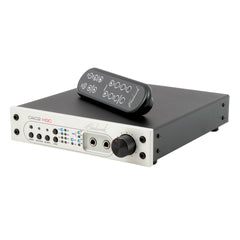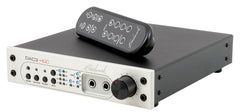Buy one component and save 10% on up to 2 cables. Buy 2 components and get 4 free cables. Free shipping on USA orders over $700. We are closed 1/1/26 and 1/2/26.
Buy one component and save 10% on up to 2 cables. Buy 2 components and get 4 free cables. Free shipping on USA orders over $700. We are closed 1/1/26 and 1/2/26.
A Look Inside the New ES9028PRO Converter Chip and the New DAC3
by John Siau November 14, 2016

The best just got better!
It has been a little over 7 years since ESS Technology introduced the revolutionary ES9018 audio D/A converter chip. This converter delivered a major improvement in audio conversion and, for 7 years, it has held its position as the highest performing audio D/A converter chip. But a new D/A chip has now claimed this top position. Curiously the successor did not come from a competing company; it came from ESS. On October 19, 2016, ESS Technology announced the all-new ES9028PRO 32-bit audio D/A converter. In our opinion, ESS is now two steps ahead of the competition!
This application note examines the differences between the ES9018 and the new ES9028PRO. It also compares the Benchmark DAC2 and DAC3 to demonstrate the performance improvements that can be achieved in a commercial product.
The New ES9028PRO D/A Converter
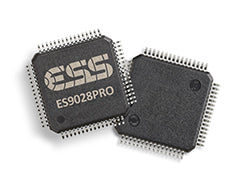
For several months, Benchmark Media Systems has been working with some early samples of the new ES9028PRO converter chip. We have conducted numerous measurements and listening tests, and I have to say that we are very impressed! As a result of these tests, we have decided to add two premium converters to our existing line of converters. The new DAC3 HGC is a high-performance version of the popular DAC2 HGC. The DAC3 L is a high-performance version of the DAC2 L (for users who don't need a headphone amplifier).
Introducing the New Benchmark DAC3
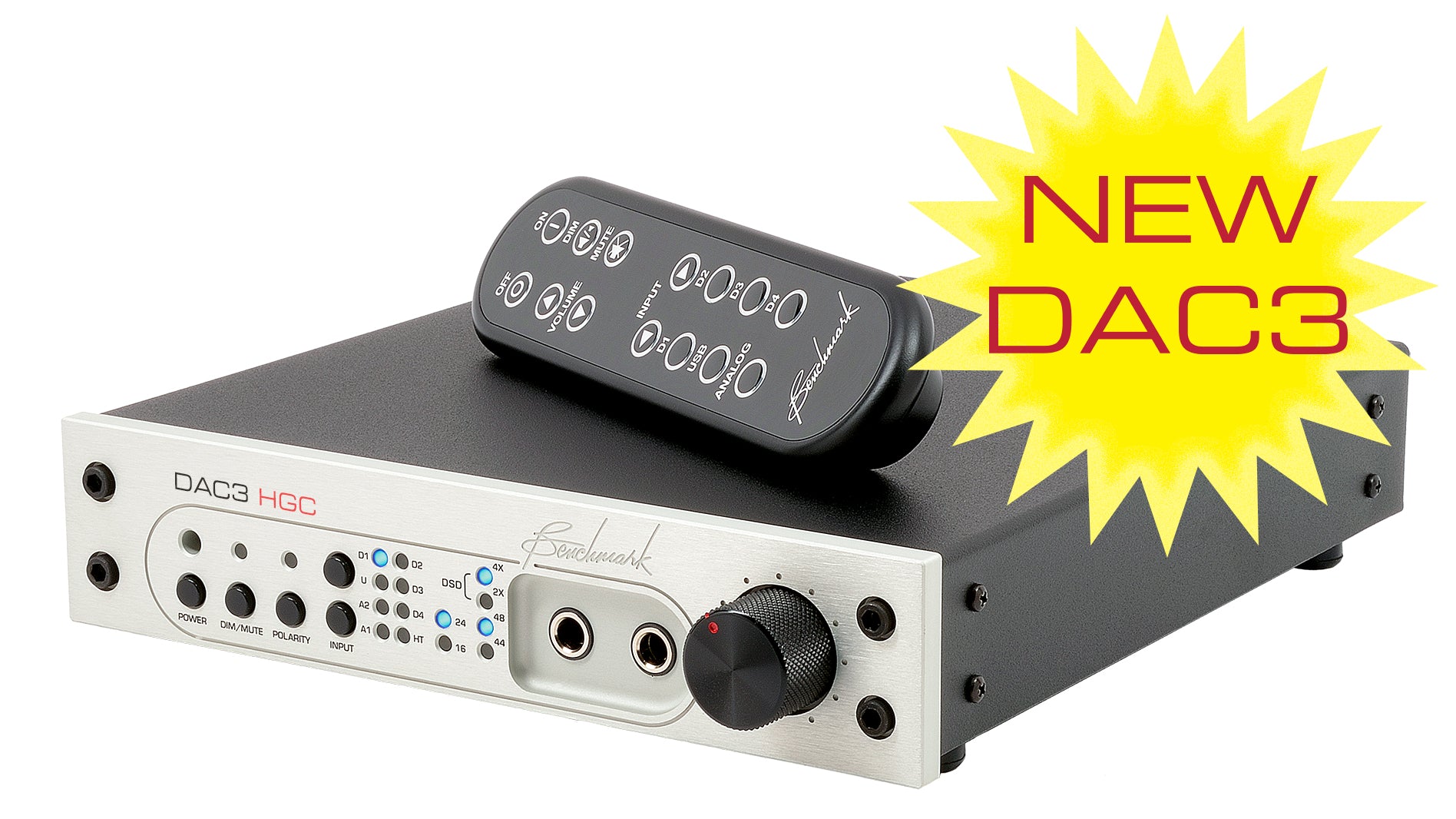
The Benchmark DAC3 is one of the first products to use the new ES9028PRO converter chip. The DAC3 is available in two models; the DAC3 HGC and the DAC3 L. Both are now in full production. These products began shipping November 14, 2016.
A Look Inside the ES9018 and the new ES9028PRO
The block diagrams below show the internal workings of the ES9018 and ES9028PRO converter chips.
ES9018 Block Diagram - (DAC2)
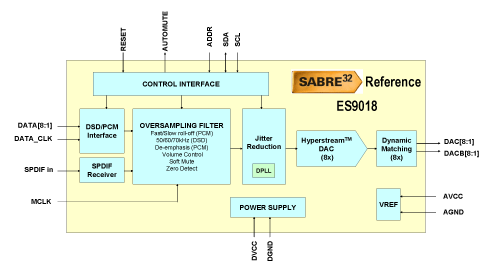
ES9028 Block Diagram - (DAC3)

Clearly the overall architecture is similar, but there are four significant performance improvements that have been added to the ES9028PRO:
- THD Compensation
- Improved oversampling filters
- Improved phase locked loop
- Improved power supply distribution
Of these, we consider the THD compensation the most clever and unique feature. The improved filters deliver a slightly flatter frequency response. The improved phase locked loop allows virtually instantaneous switching between digital inputs. The improved power supply distribution contributes to the effectiveness of the THD compensation by minimizing THD-inducing interactions between the various subsystems.
THD Compensation
This 32-bit digital processing block compensates for the THD produced by the analog outputs on the chip. It can also be adjusted to compensate for the off-chip analog components in the DAC. This system even allows independent nulling of the 2nd harmonic and 3rd harmonic distortion. The result is a conversion system that is virtually perfect in terms of 2nd and 3rd harmonic distortion!
Our tests show a reduction in 2nd harmonic distortion over the entire audio band, with the largest improvements in the midrange where our ears have their highest sensitivity. In the midrange, the compensation circuit reduces the 2nd harmonic distortion by 8 to 12 dB.
The performance of the 2nd harmonic compensation system is demonstrated in the plot below. Both traces show the 2nd harmonic distortion at the XLR outputs of the DAC3. The black trace shows the DAC3 in a special test mode where we have disabled the THD compensation. The red trace shows the normal operation of the DAC3 with the THD compensation turned on. When the THD compensation was turned off, the THD performance of the DAC3 was virtually identical to that of the DAC2. The red trace demonstrates the effectiveness of the THD compensation process. This unique processing function is one of the major performance improvements in the DAC3.
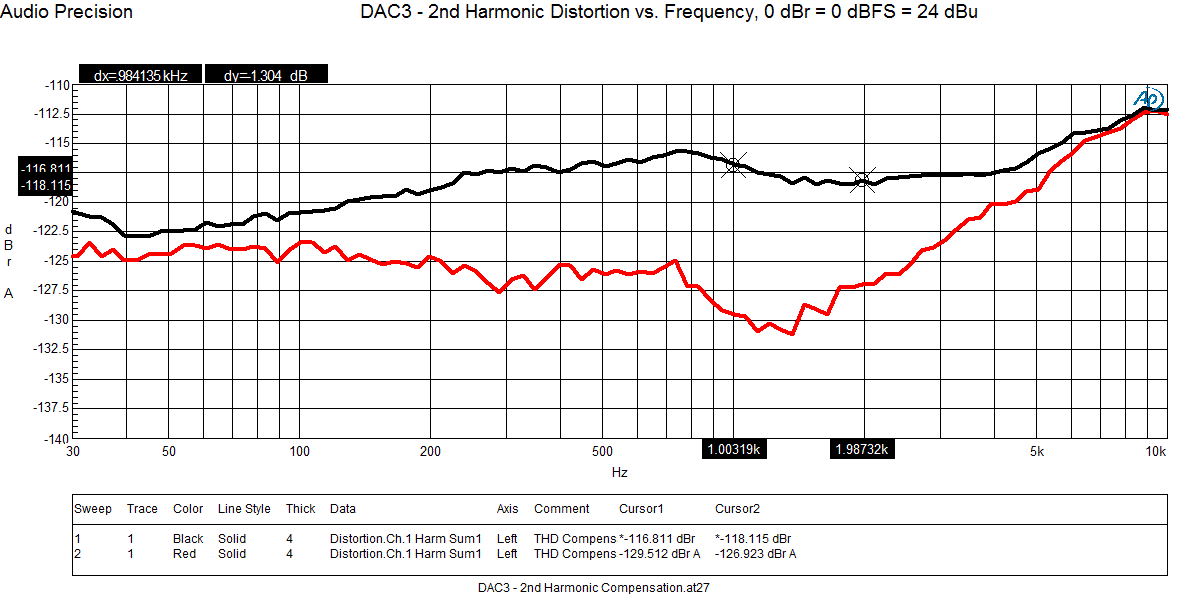
Improved Oversampling Filters
The ES9028PRO has an improved selection of filters. We have chosen the filter which provides the lowest passband ripple. This new filter exceeds the pass-band performance of the best filter available in the older ES9018.
It is important to note that the DAC2 and DAC3 converters frequency-shift the selected built-in filter by driving the converter chip at a fixed 211 kHz sample rate. This frequency shifting places the near-Nyquist region entirely above the audio band. The Benchmark upsampling system completely eliminates the time-domain errors that would have been produced by the built-in filter. The 211 kHz upsampling frequency sets the cutoff frequency of the internal filter at 105 kHz. This places the filter transition region safely above the 96 kHz Nyquist frequency of a 192 kHz input sample rate. This unique Benchmark system prevents the near-Nyquist errors that would normally be produced by the filters in the D/A converter chip. This unique 211 kHz upsampling system allows us to implement a filter that is optimized for minimum passband ripple instead of using the default filter in the ES9028PRO.
The DAC3 and DAC2 both use the Benchmark 211 kHz upsampling system, and both provide outstanding frequency-domain and time-domain performance. But, due to the improvements in the ES9028PRO, the DAC3 has slightly less passband ripple than the DAC2.
Improved Phase Locked Loop
The ES9028PRO has an improved digital phase locked loop that allows it to lock more quickly than the ES9018. The new chip can lock with high precision in less than 6 milliseconds. For all practical purposes, this is instantaneous. We have leveraged this performance and have modified the timing of our UltraLock2™ system to create the new UltraLock3™ system. Both versions of Benchmark's UltraLock™ system have near-perfect jitter attenuation and they exceed the performance of the phase locked loop that is located inside the ESS converter chips. In the DAC2, we had to delay our mute circuits by 450 ms to wait for the ES9018 to lock. But, with the ES9028PRO we have been able to reduce the mute interval to less than 6 ms.
Remarkably, the phase of the DAC3 is completely settled at the end of the very short 6 ms mute interval. In contrast, the DAC1 converters unmute in about 50 ms, but the PLL phase takes another 2 seconds to settle. The DAC2 converters mute for 450 ms, but like the DAC3, they are fully settled at the end of the mute.
The following three graphs show the improvements in lock time over the three versions of Benchmark's UltraLock™ system. Please note the time scales when comparing the plots. In each case the time scale is adjusted to show the complete mute interval. The red lines show the approximate envelopes of the mute functions. Please note that the DAC1 did not use an ESS converter chip but the DAC1 mute timing is shown to add some perspective to this discussion.
UltraLock™ (DAC1)

UltraLock2™ (DAC2)

UltraLock3™ (DAC3)

A/B Testing using the Input Selector
The ultra-fast phase-accurate settling of the new UltraLock3™ system allows seamless switching between digital inputs. The DAC3 input selector is suitable for conducting A/B comparisons between two digital inputs. The longer 450 ms mute time of the DAC2 and the long 2 second PLL settling time of the DAC1 prevent the use of the input selectors when conducting A/B tests with these products. In contrast, the DAC3 provides seamless 6 ms switching between inputs and it exhibits none of the frequency shifting that occurs when the DAC1 is settling. With the DAC3, it is now possible to make accurate comparisons between two digital sources.This is a capibility that will be appreciated by many audio professionals as well as by many home audiophiles.
ES9028PRO Performance Options
The performance and complexity of the support circuitry outside of the ES9028PRO can be configured to match a manufacturer's budget and space constraints. When Benchmark designed the DAC2 we started by using all of the ESS-recommended performance options and then we added our own set of enhancements. This same strategy is carried forward to the DAC3. Our performance-driven strategy greatly increases the number of support components, but these components add important performance improvements. For this reason, it is important to understand that there can be a wide variation in the performance of an ES9028PRO converter solution. The overall performance will be determined by the manufacturer's budget, goals, and skills.
In the DAC3, Benchmark uses the following techniques to maximise the performance of the ES9028PRO:
- 4:1 channel summing - improves the SNR by 6 dB
- External I-V converters - lower noise and lower distortion
- Precision differential amplifier - removes common-mode distortion
- Very low noise voltage regulator - Benchmark discrete design reduces noise and distortion
- UtraLock3™ jitter attenuation - virtually perfect jitter rejection
- 211 kHz Upsampling - eliminates time-domain errors caused by the D/A conversion chip
- High-headroom DSP - eliminates clipping of intersample peaks
- 6-layer circuit board with external ground planes - reduces noise and provides RF shielding
Benchmark D/A Converter Specifications
| Specifications | DAC1 | DAC2 | DAC3 |
|---|---|---|---|
| SNR - A weighted | 116 dB | 126 dB | 128 dB |
| THD+N, 1 kHz, -1 dBFS, 20 kHz LPF (dB) | -106 dB | -109 dB | -113 dB |
| THD+N, 1 kHz, -1 dBFS, 20 kHz LPF (%) | 0.00056 % | 0.00035 % | 0.00022 % |
| Frequency Response, 20 to 20 kHz | +/- 0.1 dB | + 0, -0.04 dB | +0, -0.015 dB |
| Passband Ripple | +/- 0.005 dB | +/- 0.003 dB | +/- 0.002 dB |
| Intersample Headroom | 0 dB | 3.5 dB | 3.5 dB |
| PLL Lock Time | 60 ms | 450 ms | 6 ms |
| Jitter Attenuation System | UltraLock™ | UltraLock2™ | UltraLock3™ |
| Converter Chip | AD1853 | ES9018 | ES9028PRO |
Additional Reading
Inside the DAC2 - Part 1 - Analog Processing
Inside the DAC2 - Part 2 - Digital Processing
Inside the DAC2 - Part 3 - Power Supplies
The PLL in your D/A Can Taint A/B Listening Tests!
Intersample Overs - Application Notes
Benchmark DAC2 vs. DAC1 - Side-by-Side Measurements
Products Discussed
DAC1
DAC2 HGC
DAC3 HGC
DAC3 L
Also in Audio Application Notes

How Loud is the Distortion from Your Power Amplifier?
by John Siau August 08, 2025
Would you put a Washing Machine in your Listening Room?
If the answer is no, you may be surprised to discover that the distortion produced by your power amplifier may be louder than the noise produced by a major appliance.
Don't believe me? Take a look at Stereophile's test reports:
We selected 7 power amplifiers from Stereophile's top list of recommended amplifiers.
We took Stereophile's "THD+N vs. Power" plots for each, and replotted the data in a format that shows the loudness of the THD+N at the listening position.
The results are shocking!
Amplifier THD+N is louder than expected!
The distortion from your amplifier may be louder than a washing machine on the spin cycle, or it may be totally silent. How does yours perform? The answer is hidden in Stereophile's THD+N plots.
This application note reveals the hidden truth:
"The Distortion from your Power Amplifier may be Louder than a Washing Machine!"
I know, it sounds crazy, but this is what the measurements show!

Interpolator Overload Distortion
by John Siau November 20, 2024
Most digital playback devices include digital interpolators. These interpolators increase the sample rate of the incoming audio to improve the performance of the playback system. Interpolators are essential in oversampled sigma-delta D/A converters, and in sample rate converters. In general, interpolators have vastly improved the performance of audio D/A converters by eliminating the need for analog brick wall filters. Nevertheless, digital interpolators have brick wall digital filters that can produce unique distortion signatures when they are overloaded.
10% Distortion
An interpolator that performs wonderfully when tested with standard test tones, may overload severely when playing the inter-sample musical peaks that are captured on a typical CD. In our tests, we observed THD+N levels exceeding 10% while interpolator overloads were occurring. The highest levels were produced by devices that included ASRC sample rate converters.

Audiophile Snake Oil
by John Siau April 05, 2024
The Audiophile Wild West
Audiophiles live in the wild west. $495 will buy an "audiophile fuse" to replace the $1 generic fuse that came in your audio amplifier. $10,000 will buy a set of "audiophile speaker cables" to replace the $20 wires you purchased at the local hardware store. We are told that these $10,000 cables can be improved if we add a set of $300 "cable elevators" to dampen vibrations. You didn't even know that you needed elevators! And let's not forget to budget at least $200 for each of the "isolation platforms" we will need under our electronic components. Furthermore, it seems that any so-called "audiophile power cord" that costs less than $100, does not belong in a high-end system. And, if cost is no object, there are premium versions of each that can be purchased by the most discerning customers. A top-of-the line power cord could run $5000. One magazine claims that "the majority of listeners were able to hear the difference between a $5 power cable and a $5,000 power cord". Can you hear the difference? If not, are you really an audiophile?



